
All categories
Featured selections
Trade Assurance
Buyer Central
Help Center
Get the app
Become a supplier

(427 products available)
































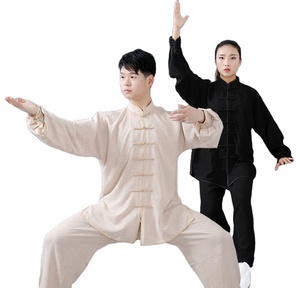

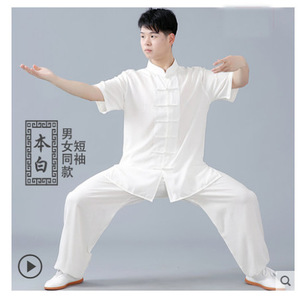
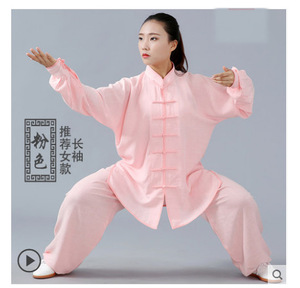
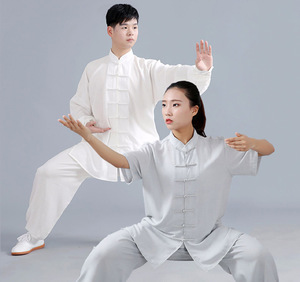
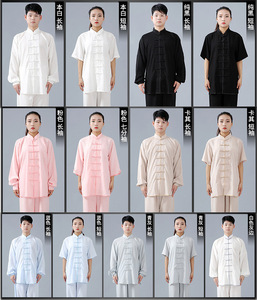






Tai Chi is a martial art that originated from China, and it is mostly practiced for its health benefits. One of the most important aspects of Tai Chi practice is the uniform, which supports free movement and provides comfort. Traditionally, there are three main types of Tai Chi uniforms, each with unique characteristics and historical significance:
Traditional Style
Traditional Tai Chi clothing is mostly loose-fitting and comfortable. The traditional colors are white, black, and navy blue, and the clothes are made from natural fabrics like cotton and silk. The traditional uniform consists of a tunic top with a mandarin collar, often decorated with Chinese symbols or patterns, and pants that are tied at the ankles. The outfit promotes relaxation and mindfulness, which is essential for practicing Tai Chi's slow and deliberate movements. The Traditional style is mostly accompanied by flat-soled shoes that are lightweight and flexible, providing stability and grounding.
Modern Style
Modern Tai Chi uniforms are still inspired by the traditional style but come in a wider variety of colors, designs, and fabrics. These uniforms are mostly designed to meet the requirements of practitioners, including those who practice Tai Chi for health, meditation, or martial arts purposes. The uniforms are mostly made from moisture-wicking and breathable fabrics, which enhance comfort during practice. The tops and pants may come in different styles, such as short-sleeved or sleeveless tops, and pants with elastic waistbands. Flat-soled shoes are still the preferred footwear, although modern designs may include additional support and cushioning.
Martial Arts Style
Martial arts Tai Chi uniforms are specifically designed for Tai Chi as a martial art form. These uniforms are mostly designed to allow a full range of motion and to facilitate the execution of Tai Chi forms and techniques. They often include specific features such as split pants, which allow for greater mobility, especially in lower stances. The tops may have buttons or ties down the front, resembling a jacket. The outfits are usually in solid colors, often representing different Tai Chi styles or schools. Flat-soled shoes are commonly worn, but some practitioners may prefer going barefoot, especially in a training environment.
When selecting the right Tai Chi uniform for practitioners and matching it with the right accessories, there are various factors that need to be considered to ensure comfort and proper performance. Here are some suggestions:
Fit and Comfort
The uniform should be comfortable and well-fitting. It should not be too tight or loose. It should allow for full range of motion. Try the uniform before buying it. It should fit well and feel comfortable. It should not restrict movement in any way. There should be enough room to move around freely without the clothes getting in the way of the practice.
Fabric Selection
Choose a fabric that breathes well. Natural fibers like cotton are excellent choices. They keep the body cool and dry during practice. Synthetics like polyester can also work. But they should be blended with natural fibers. Linen is another good option. It wrinkles but it keeps the body cool. Silk is luxurious but it may not be practical for all. It is expensive and delicate. Hemp is eco-friendly and it offers excellent breathability. It is also durable and it gets softer with each wash. Bamboo fabric is another sustainable choice and it is soft and moisture-absorbing. The right fabric enhances comfort and performance in Tai Chi practice.
Color and Symbolism
Traditionally, Tai Chi uniforms come in various colors. Each color has its unique meaning and significance. White is the most common color and it symbolizes purity and tranquility. Black represents depth and introspection while red signifies energy and passion. Blue is associated with calmness and peace and yellow symbolizes warmth and openness. The choice of color can reflect the practitioner's personal preferences and the qualities they wish to cultivate in their Tai Chi practice. Some uniforms also feature symbols or patterns. They may have dragons or yin-yang motifs. These add a layer of cultural significance and spiritual meaning to the attire.
Style and Design
Choose a style that suits your practice level and preference. The cut and design should allow for free movement. Traditional designs often feature split skirts and high collars. Modern variations may offer more casual fits. Consider the climate where the uniform will be worn. Warmer climates may require lighter fabrics. Cooler climates may call for layered options. Accessories like sashes, belts, or hats should complement the uniform. They should not restrict movement or comfort. Select colors that align with personal preference or school requirements. Some schools have specific colors for their uniforms. This requirement should be considered when choosing a uniform. The design elements should enhance the overall aesthetics without compromising functionality.
Q1: What colors are Tai Chi uniforms available in?
A1: Tai Chi uniforms come in a variety of colors. However, white, black, and blue are the most common. Other colors include yellow, grey, and green. They may also feature traditional patterns or insignias.
Q2: Are Tai Chi uniforms suitable for other martial arts?
A2: Yes, Tai Chi uniforms are suitable for other martial arts. For example, they are ideal for Qigong or Yoga. This is because they are loose-fitting and comfortable, allowing for free movement and relaxation.
Q3: Can Tai Chi uniforms be worn casually?
A3: Yes, Tai Chi uniforms can be worn casually. They are comfortable and stylish, making them suitable for everyday wear. This is even when one is not practicing Tai Chi or martial arts.
Q4: Are Tai Chi uniforms unisex?
A4: Yes, Tai Chi uniforms are mostly unisex. They are designed to fit both men and women comfortably. However, some styles may be more flattering on one gender than the other.
Q5: Are Tai Chi uniforms only for seniors?
A5: No, Tai Chi uniforms are not only for seniors. While Tai Chi is often associated with older adults, it is beneficial for people of all ages. Therefore, uniforms are designed for anyone practicing Tai Chi, regardless of age.